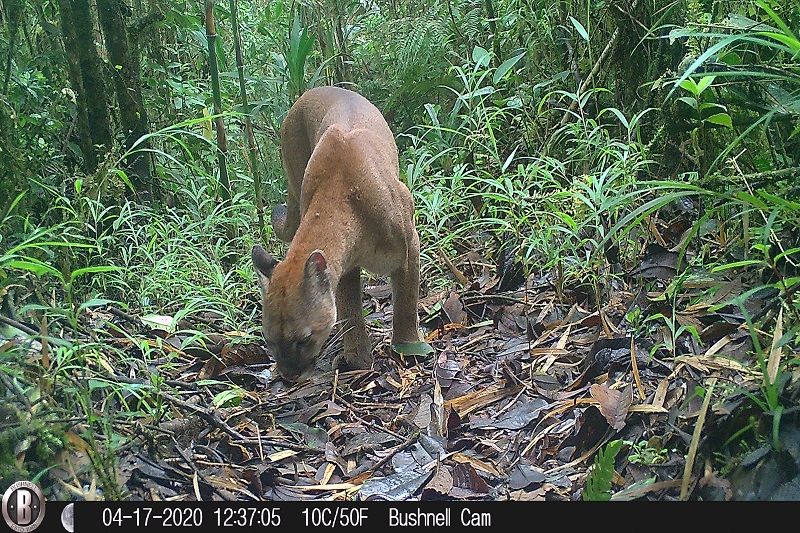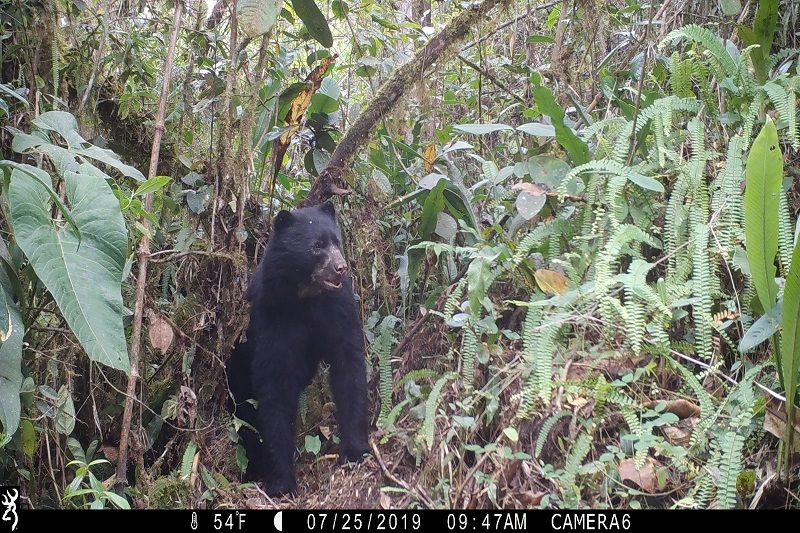Wildlife haven in the heavens
Teeming with wildlife, the threatened cloud forests of Ecuador now face a more secure future thanks to the efforts of the Rainforest Concern team. The Neblina Reserve, a global biodiversity hotspot, was granted official conservation status in 2009, protecting over 1,000ha of forest. In the decade since then, the Rainforest Concern team identified six new areas of land which were added to the reserve in 2018, extending the protected area to almost 1,700ha.
The cloud forest ecosystem
The cloud forest is unique due to its physical factors. These include its location in the Andes, its position right on the equator, the marine currents, winds, and Amazonian influences that all affect it in different ways, making it the exceptional habitat it is. But like so many of our precious habitats it’s under threat. Threat from changing land use, mining and deforestation. We need to protect the forest but knowing which areas to protect requires an understanding of how the ecosystem functions and which species are critical players.
Neblina Reserve is home to almost 450 mammals, 46 of which are endemic. Andean or spectacled bears are one of the largest mammals living in Ecuador. They are also critical for the future of the cloud forest. Known as an ‘umbrella’ species, their way of life helps support much of the wildlife around it. This is because they eat a hugely diverse range of fruits and plants, spreading the seeds far and wide as they roam huge distances across the mountain. Seeds from over 300 plants species are dispersed by the bears! As the Andean bears move across degraded areas, they help entire ecosystems to regenerate.
Learning more about the forest
Throughout Neblina, one incredible ecosystem gives way to another, with increasing altitude. Evergreen montane forest turns into paramo grasslands at 3,400 metres above sea level. Palm trees and tree ferns dominate the lower slopes, mature forest trees host numerous bromeliads and there are even groves of native bamboo. Sonja Dillman and Tashkin Meza, from Rainforest Concern, have been leading their team for the past two years, putting camera traps out throughout the reserve to identify which species are found in which parts. During the exercise the team has trained up forest guards so they are now skilled at identifying not just the animals that live there but also their tracks.
The main drivers of deforestation in the region are increases in small-scale agriculture. About 70 communities live in and around the area, and the population of 17,000 is growing at a rate of 1% a year. Engaging the local community, explaining how important the cloud forest is, and what natural wealth it holds has been a really important part of the team’s work.
Results from the camera traps
Rangers Milton Arcos, Armando Almeida and Alberto Tabango were responsible, with Tashkin, for investigating where best to place the camera traps. Selecting suitable tree trunks along clear pathways, the cameras were programmed to take images night and day to make sure nocturnal and diurnal species were spotted. Images were collected of 18 different mammal species including the white-nosed coati, nine-banded armadillo, Central American agouti, striped hog-nosed skink and, happily, the Andean bear. Most of the mammals recorded were carnivores, with rodents, marsupials, deer and armadillo also being found.
Seventeen individual bears were identified in the photographs, and of these 13 were adults. Most of their activity was during the day, in particular early morning and early evening. Not surprisingly they had a very varied diet, feeding on bromeliads, orchids and avocados between April and July, and between July and September they fed mainly on motilónes (a native shrub). They also consumed the fruits, buds, stems and tender leaves of the other plants present in the forests and páramo, such as anthuriums, puyas, orchids, mortiños (similar to bilberries and blueberries), frailejones (a shrub from the sunflower family), aguacatillos (a type of avocado), motilones, arrayanes, chaquilulos, figs, palo ajo, and suro (an understory bamboo).
Using the bears as a tool, the team can identify and design landscape scale conservation areas for protection. Taking into account their preferred habitats (based on what they eat and other resources that they need) and how they interact with human-made landscapes, guidelines can be created. The camera trap images reveal that bears spent most of their time in the montane evergreen forests, with some excursions into pasture and crop fields. Most of their time was spent on pretty steep slopes – possibly because these were the areas that hadn’t been deforested – and between 2,400-3000 metres above sea level.
Building partnerships
The future of our rare and threatened cloud forests, like the Neblina Reserve, depends on us being able to give them proper protection. Rainforest Concern do this by supporting the local communities, providing education, management, and patrols. Direct conservation measures are important too – like buying tracts of land, as we have in this project. Land purchase, easements or registration are done in the name of local communities or indigenous peoples to ensure the forests are really secure in the long term. Building effective partnerships with local NGO’s, which helps to underpin and direct research and monitoring, is also critical. With large scale threats to the forest from mining, infrastructure development and climate change, and other threats such as unsustainable agriculture, research projects like this Andean bear survey are more important than ever. Thanks to PTES’ supporters, Andean bears and the many other species that make Neblina Reserve their home, are facing a more secure future.
Thank you for helping us fund this research to protect Andean bears in Ecuador.
If you’d like to support work like this, please donate or set up a direct debit today


